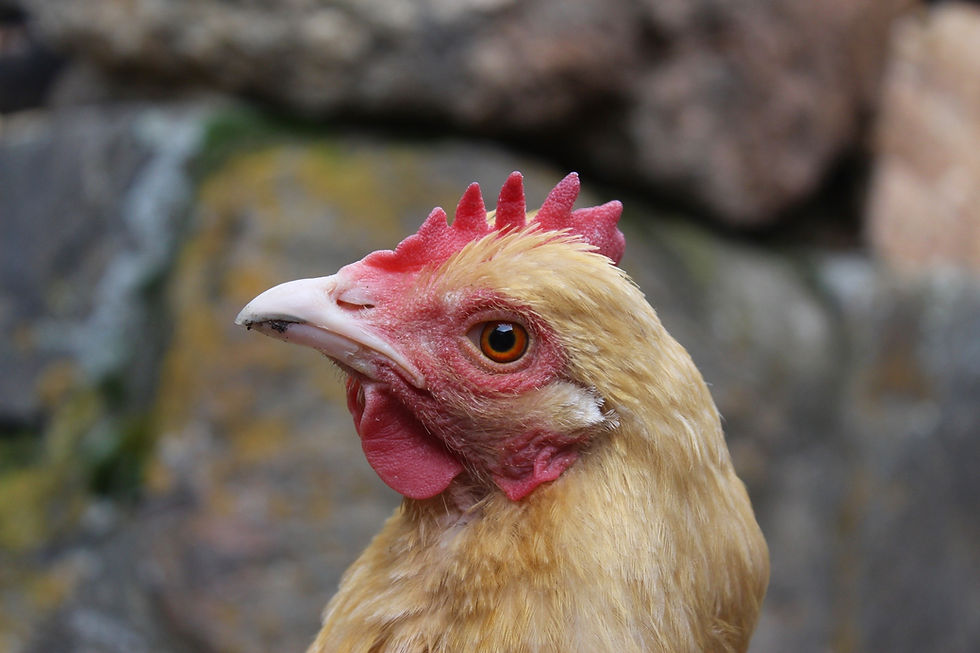Facts on Chicken Eyesight
- Sarah Reinertsen
- May 2, 2019
- 4 min read
Don't laugh, chicken eyesight is actually amazing. A couple years ago, the website I write articles for, called Backyard Chickens asked me to write something new for them since I hadn't in a while. I decided to research something I had no prior knowledge of, and this blog post is the result of that research. I guarantee you will learn something new and interesting in this article! For starters, did you know chickens can see better in color than humans? What's more is they actually can detect and see shades of light better than humans, have three eyelids, can move each eye independently, and have a 300 degree field of vision without having to turn their head.
Chickens see the same way we do. Light refracts and enters their eye through the cornea and iris which then stimulates nerve endings in the retina at the back of the eyeball transferring images to the brain. One of the big differences, however, is that chickens have tetra-chromatic vision, while we have tri-chromatic. Chickens have four wavelengths (blue, red, green and ultraviolet light) while we can only have three (blue, red and green.) Therefore, chickens’ color vision is different from ours and even more enhanced than ours is. Because they have colored filters mixed with nerve cells. They are like little drops of oil filtering out different wavelengths and act similarly to wearing yellow goggles when skiing.

The fact that chickens see an extra sector of the light spectrum means that everything they see looks slightly different from what we see. We can't observe how much ultraviolet light is reflected off any substance whereas chickens can actually see ultraviolet light! Chickens also have better motion-sensing ability than we do. This is important to keep in mind if you use or plan to use artificial lighting in your chicken coop. These lights flicker at a rate that surpasses what we can see. Nevertheless, this flickering can be bothersome to a flock and may actually cause them to start bullying each other and pecking at one another.
Birds as well as other mammals have a structure called a fovea within their retinas. Essentially, it is a small pit that, because of its shape, acts as an image enlarger. Chickens have two foveae, each acting a little differently. One is for seeing things at a distance, and the other is for close up vision. The interesting thing is that the up close foveae is oval and sideways and that’s why, when you approach your chicken, they will often bob their heads and tilt their heads sideways to get the image of you into a clearer view. Shockingly, chickens actually can’t easily recognize flock members until they are within about 24 inches. But, what also is just as shocking is that once chickens can see clearly who is within their vision range, they can recognize over 100 individuals, may it be other flock members, humans, or predators!
So yes, chickens have excellent eyesight. But they, like humans and many other animals, are completely blind when it is dark. It goes without saying that we need color and/or light to be able to see, and so do chickens. But, what's interesting is that chickens are blind when it is not completely dark. Therefore, chickens are incredibly zombie-like at night. They are completely defenseless and highly susceptible to predator attacks at night.
A chicken's keen eyesight helps them watch for predators, keep track of each other, and find food each day. They use their exceptional color vision to find bugs and other insects and also steer clear of certain plants and other hazardous objects. Amazingly, hens use their ability to see color so well to observe which of their baby chicks are the healthiest. The wavelengths of ultraviolet light help hens to notice minute details and traits on the chicks' feathers. Those with the shiniest and clearest plumages are healthiest and thus have the best chance of survival.
Now, get this! Before chicks hatch, they usually turn in the shell so that their right eye is next to the shell and therefore their body covers the left eye. Once they hatch, their right eye develops near-sightedness, which allows them to search for food and other things, while the left eye develops far-sightedness, allowing them to search for predators from afar. That is why when a bird of prey flies overhead, chickens tilt their heads with their left eye up to the sky. How crazy is that?!
Another interesting fact regarding chicken eyesight is that they have a third eyelid. Yup, you read that right. Sometimes when we as chicken owners take a picture of one of our birds, we sometimes notice that the chicken’s eye appears hazy or somewhat blurry. At first glance this looks like a glitch in the camera, but actually this is the chicken’s third eyelid called the nictitating membrane. The nictitating membrane is positioned next to the eyeball, underneath the other two eyelids and works independently from them. It operates by sliding from the front to the back of the eye. It has two purposes: cleaning and protecting. When a chicken takes a dirt bath, you will see the nictitating membrane appear. It is protecting the eye from any dirt entry. Another time you may see it appear is when your chicken is sleeping. They sometimes don’t close their eyes completely, and thus, the nictitating membrane covers the eye instead.
So there you have it! Were you surprised? I told you chicken eyesight was fascinating! You're probably shocked and wondering, "Sarah, how could you write, rant, and ramble about something as random as a chicken's ability to see for eight whole paragraphs?!" Oh, just you wait, my friend; this is only the beginning! ;-) Anyway, I hope you enjoyed! Thanks for reading.
-Sarah




Comments